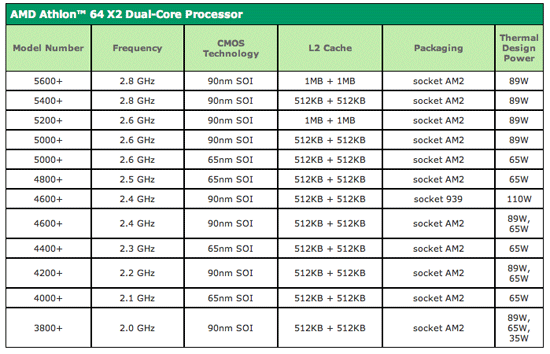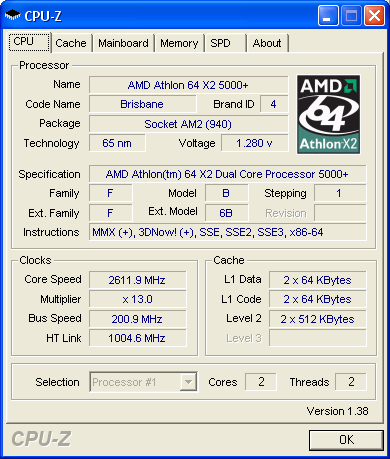AMD's 65nm Brisbane Core Previewed: The most energy efficient AMD CPU to date
by Anand Lal Shimpi on December 14, 2006 6:08 PM EST- Posted in
- CPUs
When Intel launched its Core 2 line of processors we saw AMD's performance and power advantages vanish into thin air but the comparison, at least on the power side, wasn't totally fair. Intel had been shipping desktop processors on its 65nm process for months prior to the launch of Core 2, while AMD's Athlon 64 X2s were still built on a 90nm process. We had no way of telling how much of Intel's power advantage was due to a more efficient architecture or simply smaller, cooler running transistors. Up to now, AMD has been penalized twice in all Core 2 vs. Athlon 64 X2 comparisons; AMD's new micro-architecture won't debut until next year and neither will 65nm in any great quantities.
Technically in-line with roadmaps, AMD just introduced and announced shipment of its first 65nm cores: codenamed Brisbane. Availability is another story entirely, as it's looking like we won't see any real quantities of these things until Q1 2007. Right now AMD's Brisbane chips are strictly OEM only and AMD wasn't able to give us an indication of when to expect retail/channel availability. Of course we wouldn't be talking about this today if we didn't have a chip, which we do, but for all intents and purposes you can consider this a preview of what to expect in the new year from AMD's first 65nm chips.
AMD announced its Brisbane lineup earlier this month, the chips and basic specs are listed below:

As you can expect, AMD is pricing the 65nm chips in line with its 90nm offerings to encourage the transition. Die size and TDP have both gone down to 126 mm^2 and 65W across the line. As AMD improves its 65nm SOI process you can expect to see even lower wattage parts, but for now all of the 65nm chips are rated at 65W TDP.
Transistor count remains unchanged at 154M as there is no new functionality or cache introduced with the move to 65nm. Once again, we will have to wait until around the middle of 2007 before we'll see any major changes to AMD's architecture.

The chip we received was AMD's 65nm Athlon 64 X2 5000+ and from the outside, it looks just like a normal X2. The only way to tell that this is a 65nm chip is by looking at the OPN.

Armed with the chip and its $301 price point we set out to compare its performance, power consumption and power efficiency to AMD's other 90nm CPUs and the closest price competitor from Intel: the Core 2 Duo E6600 priced at $316.










63 Comments
View All Comments
Tilmitt - Thursday, December 14, 2006 - link
This "Performance per Watt" marketing bullshit has gone too far. Strange how Anandtech only started including it when Intel started marketing it insanely.To hell with performance per watt, give me performance.
Mantruch - Tuesday, December 19, 2006 - link
Indeed.. who give a sh*t about watt/performance, this is a desktop cpu not mobile...who sold this article to amd ? lol
Locutus465 - Saturday, December 16, 2006 - link
No... This was one of the major topics of discussion in the A64 v. P4 days as well, only AMD was enjoying Intel's current position. So Intel has a better chip right now, whats the big deal? This is why we like compitition.
Genx87 - Friday, December 15, 2006 - link
We didnt use to care about performance\watt in the consumer sector and left that to the professional arena. But ever since the power draw and heat of the consumer boxes started to rival professional level boxes it is good to see what you are getting.Gone are the days of a 250 watt PSU and a system that is passively cooled.
Frumious1 - Thursday, December 14, 2006 - link
Seems to me performance per watt is AMD's only leg to stand on right now (unless you just want to go with pure power draw). If you just look at performance AMD is even farther behind and that won't change until we see K8L, and maybe even that won't be enough. It's good to see lower temps and power requirements from AMD as it shows they're at least doing something other than sitting around bemoaning their fate. Intel already wins the marketing war, and now they're killing AMD on performance as well.Would have liked to see more CPUs for the comparison, though - like how about a 65nm 4600+ and 3800+ to see how they match up with the EE/EE SFF chips? Getting an E6300/6400 in as well would ahve been nice. Last, the use of an 8800 GTX is going to skew the "performance per watt" numbers, but it should still be consistent in this one set of benchmarks. As long as we don't get comparisons using other GPUs thrown in, it's probably the best you can do. Still would be nice to know how much power the CPU is really drawing on all these tests - probably less than 50W would be my bet.
yyrkoon - Thursday, December 14, 2006 - link
Intel won WHAT marketing war ? More like they won a battle, after losing many to their competitor, for around two years. Also, unless something has changed recently that I'm unaware of, AMD also leads in memory bandwidth, not that THAT much memory bandwidth translates into real world performance.I don't know which platform you like, and to be honest, I don't really care. However it would behoove us all, to realize that AMD, and Intel are both good companies, and if one were to go missing, we ALL would be in a much worse "market".
Frumious1 - Friday, December 15, 2006 - link
Right now, I prefer Intel. Oddly enough, though, I'm still running AMD Opteron 165 overclocked to 2.6 GHz, because it's fast enough. Better? Nope, but good enough. So I preferred AMD when they were ahead.My point about marketing is that Intel has always had the lead there - ALWAYS! How many AMD commercials do you see? A few, maybe. Intel floods the airwaves with adverts. Being better at marketing doesn't make your products superior, but if you own the mindshare of the common man it can make it damn hard for others to compete. Hell, with the junk that was Prescott (and the later NetBurst stuff), the fact that most corporations were still buying Intel says something, doesn't it? Yes, AMD made a lot of gains, but with Intel back in the lead those gains are eroding fast.
I for one hope K8L kicks some serious ass. HOPE. I remain unconvinced that AMD can close the gap and then some in the next 6 months. We shall see. Let's just hope it's not more of this Quad FX craziness. If I wanted two dual core AMD CPUs, I think I probably would have bought an Opteron 2xx setup a while back. Unbuffered RAM might improve performance a bit (5% or so?) but not enough to matter. As for octal core systems (dual quad core), don't make me laugh. That's great for the server market, and maybe even high end workstations, but on the desktop we're years away from being able to utilize/need that much CPU power.
Frumious1 - Friday, December 15, 2006 - link
Well, better a double post than to lose all that I typed. It looked like the post didn't go through, I luckily had it copied first, and after three refreshes I posted again. Naturally at that point both posts show up.yyrkoon - Saturday, December 16, 2006 - link
I don't know what current Intel CPUs memory bandwidth is, but at the time I checked my AM2 3800+ (single core) the closest thing was a core 2 duo at around 8-10GB/s bandwidth. After dropping the multiplier on my AM2 CPU, and increasing the "FSB" to 250MHZ, memory bandwidth on my 3800+ AM2 was over 11GB/s. I didn't test before hand, well maybe I did, but I don't recall what it was, so . . . I may have posted somewhere on the anandtech forums. Anyhow, I'm pretty sure its much more than 5% differences between the two, but like I said, it does not translate into real world performance, so it's pretty much moot.Frumious1 - Friday, December 15, 2006 - link
Right now, I prefer Intel. Oddly enough, though, I'm still running AMD Opteron 165 overclocked to 2.6 GHz, because it's fast enough. Better? Nope, but good enough. So I preferred AMD when they were ahead.My point about marketing is that Intel has always had the lead there - ALWAYS! How many AMD commercials do you see? A few, maybe. Intel floods the airwaves with adverts. Being better at marketing doesn't make your products superior, but if you own the mindshare of the common man it can make it damn hard for others to compete. Hell, with the junk that was Prescott (and the later NetBurst stuff), the fact that most corporations were still buying Intel says something, doesn't it? Yes, AMD made a lot of gains, but with Intel back in the lead those gains are eroding fast.
I for one hope K8L kicks some serious ass. HOPE. I remain unconvinced that AMD can close the gap and then some in the next 6 months. We shall see. Let's just hope it's not more of this Quad FX craziness. If I wanted two dual core AMD CPUs, I think I probably would have bought an Opteron 2xx setup a while back. Unbuffered RAM might improve performance a bit (5% or so?) but not enough to matter. As for octal core systems (dual quad core), don't make me laugh. That's great for the server market, and maybe even high end workstations, but on the desktop we're years away from being able to utilize/need that much CPU power.